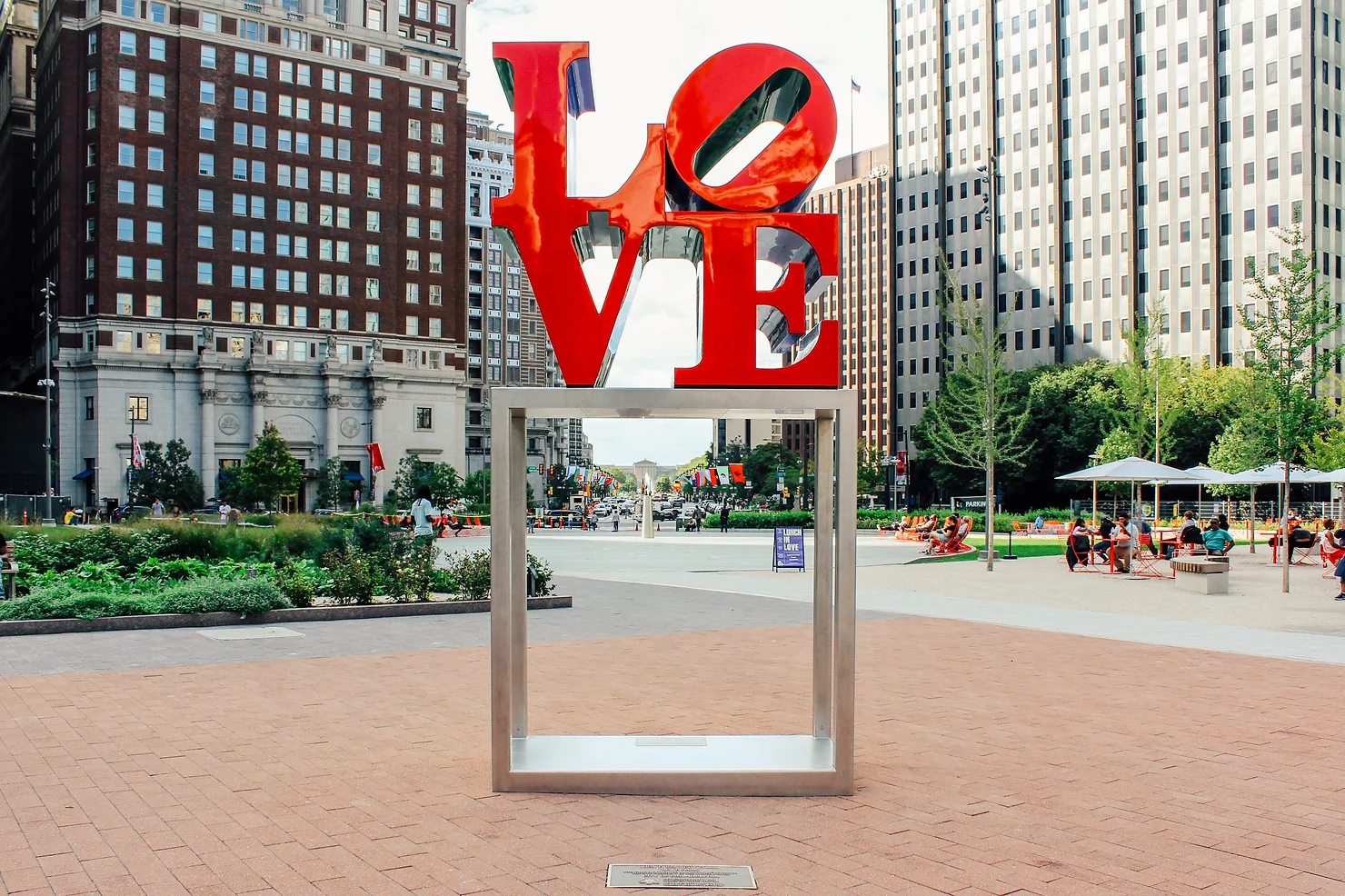For a major metropolitan area with a crucial role in America’s history, Philadelphia feels surprisingly small. However it makes up for this with beautiful parks and waterways, an abundant food scene, and enough art to make you dizzy.
The birthplace of the American Revolution might be the country’s second largest city, and is just 100 miles southwest of New York, but it has a more community feel. Nicknamed the City of Brotherly Love, getting a picture beside the infamous LOVE statue by Robert Indiana in Love Park near City Hall is essential; and if you are in town over new year, the Mummers Parade (which is often compared to the New Orleans Mardi Gras) is a massive carnival which involves more than 10,000 adults and children twirling, sashaying, pirouetting and strutting through the city’s main streets on January1st where everyone is welcome.

Another custom synonymous with Philadelphia is the Philly Cheesesteak. Legend says it was invented during the depression by two brothers who owned a hot dog stand; running out of dogs one day, they realised the next best thing was grilled beef and onions, which proved just as popular, and later oozing melting cheese was added to the mix. Arguably, John’s in South Philadelphia is the place to burst your cherry where you’ll join the queue of hungry tourists and locals who flock for a sub (you can snap up a veggie version too).

Food is a major draw for visitors to the city, and there are countless restaurants and pubs to enjoy the city’s eclectic cuisine, which comes from being such a cosmopolitan city. Head to the oldest pub, McGillin’s Olde Ale House, which was opened in 1860 by Irish immigrant McGillan; or the vibrant ChinaTown which is fronted by impressive Friendship Gates. Offering Chinese, Thai, Vietnamese and Korean street food and restaurants, you can also do some serious shopping.

Close by is Independence Hall, where the US founding fathers signed the Declaration of Independence and you can pre-book a tour, whilst opposite in landscaped gardens is a museum dedicated to the famous Liberty Bell. The bell no longer chimes, but you can see the cracked dome and original inscription, “proclaim liberty throughout all the land unto all the inhabitants thereof” which has become one of the most recognisable symbols of freedom in the world.

Another thing Philadelphians celebrate is art. You could lose yourself for days admiring the 4,000 commissioned murals which adorn the cityscape. Created under the Mural Arts Philadelphia programme, it promotes the message that art ignites change. It also offers art classes for prisoners and former prisoners and encourages them to contribute to public murals. Take a guided tour of the Mural Mile which will not only explain the history of the artworks, you can learn about the culture of various neighbourhoods.

From oversized artworks to Van Gogh’s diminutive Sunflowers, and a replica of Rodin’s The Thinker, the city is filled with galleries to feast your eyes. If classic Pissarros, Renoirs and Monets are your thing, head to the Philadelphia Museum of Art which also has a sculpture garden, Buddhist temple and rota of visiting exhibits; if you’re feeling energetic you can burn off some calories by re-enacting Sly Stone’s training routine in the Rocky films by nipping (or walking) up the 76 steps at its back entrance (or perhaps you’d just prefer a picture by his life-size statue at their foot).

Whilst the Barnes Foundation is smaller, but no less impressive. The current location is an almost exact replica of collector Albert C. Barnes’ manor house, which relocated to its prime spot on Benjamin Franklin Parkway in 2012. An avid collector, every inch of wall space is bursting with a kaleidoscope of colours, which are showcased not by genre, artist or chronology, but by form, style and colour with Picassos, Matisses and Cézannes rubbing shoulders with iron sculptures and everyday objects made by unknown artists.

Isaiah Zagar, is another Philadelphia legend. As a living mosaic artist, he uses day-to-day objects like cracked ceramics, broken bottles, mirror fragments, handmade tiles, misshapen bicycle wheels and knick-knacks to create living art. His “Magic Garden” on South Street, is an art environment that he began in 1994 and is now a non profit immersive gallery space where visitors can explore the creative mind of the folk art hero. If you don’t have a chance to visit this fascinating location, Zagar’s artwork can be found on more than 200 public walls, with most in the South Philadelphia neighbourhood.

Complimenting the arts scene, the nightlife is just as vibrant. Check out the sophisticated rooftop bars in trendy Centre City, or if you’re looking to stay up a little later, lively Gayborhood is filled with cocktail bars, clubs and cabaret. Shoppers should check out Fishtown for cool boutiques, and stop at La Colombe Coffee shop for a “draft latte” – coffee-infused rum. Each neighbourhood has its own bar scene, but don’t be surprised to find that many restaurants offer a Bring Your Own Beer (BYOB )service due to Pennsylvania’s strict liquor laws. However, if you don’t need wine with your dinner, the Reading Terminal Market was once a railroad hangar, and is now a ginormous food hall selling every kind of street food imaginable. I would suggest doing a couple of circuits to get the idea of what’s on offer before making your choice, and if you have room for dessert, the classic butter-dipped pretzels and homemade Bassett’s ice cream are heaven on earth.

Whether you’re intrigued by Philly’s history, art or foodie scene, there is lot to inspire you at any time of the year.
For more information, check out DiscoverPHL.com
By Sara Darling



























































































